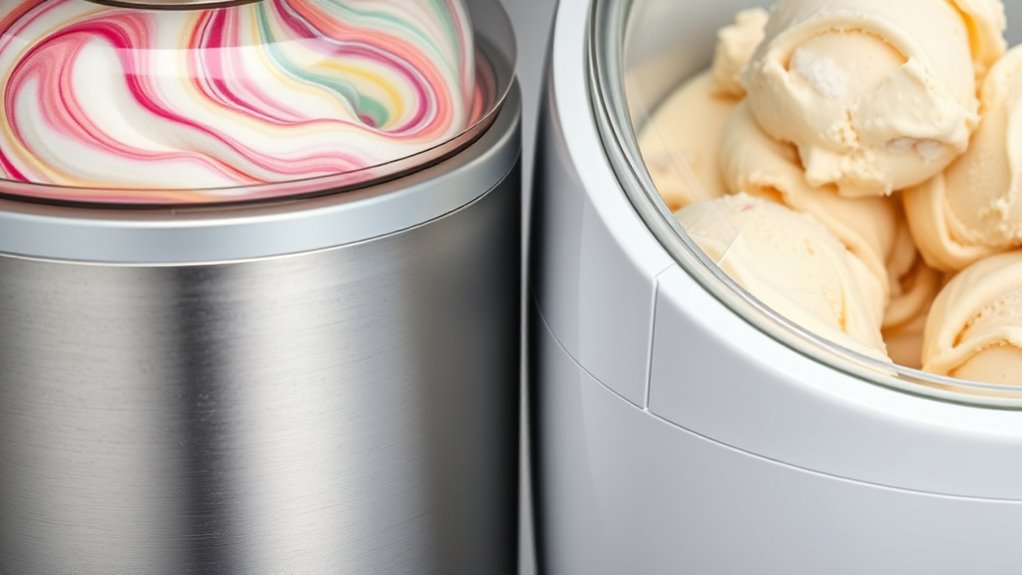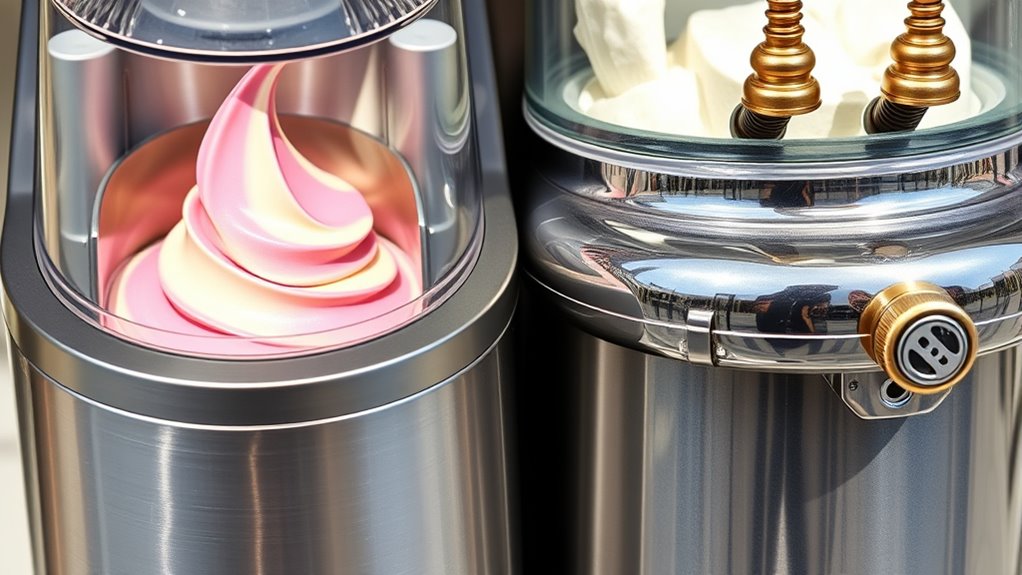If you want to make airy, fluffy ice cream, you’ll want an ice cream machine that incorporates more air and uses higher fat ingredients like cream and eggs. For a denser, smoother gelato, a gelato machine reduces air and uses more milk with less fat, giving you a rich flavor burst. The key differences lie in how each machine churns and the ingredients used. Keep exploring to discover more about which machine suits your taste and texture preferences perfectly.
Key Takeaways
- Ice cream machines incorporate more air (overrun), resulting in a lighter, fluffier texture; gelato machines produce denser, velvety desserts with less air.
- Ice cream recipes use higher fat content (cream and eggs), while gelato relies on more milk and fewer or no eggs, affecting richness and flavor intensity.
- Ice cream is churned at colder temperatures, melting more slowly, whereas gelato is churned slightly warmer for a smoother, silkier consistency.
- The production process for ice cream involves more aeration, giving it a voluminous feel; gelato’s less aeration makes it denser and more intense.
- For airy, rich textures and diverse flavors, choose an ice cream machine; for dense, smooth, and flavorful gelato, opt for a gelato machine.

When it comes to making frozen treats at home, choosing between gelato and ice cream machines can be confusing. You might wonder how these machines produce such different textures and flavors. The primary difference lies in their texture and ingredient variations, which profoundly influence the final product. Ice cream machines typically churn a mixture that contains more cream and often more sugar, resulting in a richer, creamier texture. Gelato machines, on the other hand, produce a denser, silkier dessert with less fat and air incorporated during churning. This difference in texture is noticeable; ice cream tends to be fluffier and more voluminous due to the higher air content, while gelato feels smoother and more velvety because it’s churned at a slightly warmer temperature, reducing overrun. Additionally, the air incorporation process in ice cream production contributes significantly to its lightness, contrasting with gelato’s dense structure. The churning process also affects how much air is infused, directly impacting the final texture of each dessert. It’s important to note that the ingredient composition directly influences how each dessert melts, with gelato’s lower fat content causing it to soften faster and melt more quickly in your mouth, giving you that characteristic velvety sensation.
Ingredient variations also play an essential role. Ice cream recipes rely heavily on cream, whole milk, sugar, and sometimes egg yolks, creating a decadent, full-bodied flavor. The higher fat content in ice cream contributes to its creamy mouthfeel and helps carry the flavors well. Gelato, however, generally uses more milk and less cream, and often excludes eggs. This lighter ingredient profile results in a lower fat content, which enhances the intensity of the flavors because there’s less fat to mask the taste of the fruit, nuts, or other mix-ins. The ingredients also influence how each dessert melts; gelato’s lower fat content causes it to soften faster and melt more quickly in your mouth, giving you that characteristic velvety sensation. Recognizing these ingredient differences can help you tailor your frozen treat to your preferred taste and texture.
Understanding the texture differences and ingredient variations can help you choose the right machine for your preferences. Your choice of machine should consider these differences. If you prefer a dessert that’s airy and rich with a variety of flavor options, an ice cream machine might be your best bet. It’s designed to incorporate more air and fat, creating that classic fluffy texture. If you’re after a more intense, smooth, and dense treat, a gelato machine will help you achieve that authentic, restaurant-quality gelato. Keep in mind that the process and ingredients are intertwined, and your selection influences the final product’s texture and flavor profile. Understanding these fundamental differences can help you decide which machine suits your taste and culinary ambitions better. Whether you’re after the traditional creaminess of ice cream or the silky richness of gelato, knowing how texture differences and ingredient variations shape each dessert will guide you in mastering your frozen creations at home.
Frequently Asked Questions
Can Gelato Machines Make Sorbet or Yogurt-Based Desserts?
Yes, gelato machines can make fruit sorbets and dairy yogurts. They’re versatile enough to handle non-dairy ingredients like fruit sorbets, blending frozen fruit with sugar and water, and dairy yogurts for creamy textures. Just adjust the settings for the right consistency. With your gelato machine, you can easily create invigorating fruit sorbets and smooth yogurt-based desserts, giving you more options beyond traditional gelato.
What Is the Typical Lifespan of a Gelato Versus Ice Cream Machine?
Imagine your machine as a trusty partner, ready to serve up sweet delights. Typically, gelato machines last around 8-12 years with proper maintenance, while ice cream machines can go 10-15 years. Your machine’s durability depends on how well you care for it and how often you perform maintenance. Regular cleaning keeps both machines running smoothly, extending their lifespan and ensuring delicious treats for years to come.
Do Different Machines Require Different Cleaning and Maintenance Routines?
You’ll find that different machines do require different cleaning and maintenance routines. For example, gelato machines often need more frequent machine cleaning to prevent ice crystal buildup, while ice cream machines may require thorough maintenance routines to keep the churning mechanism in top shape. Always follow the manufacturer’s instructions for your specific machine, and regularly clean all parts to guarantee peak performance and longevity.
Are There Specific Machine Features Better Suited for Commercial Use?
When choosing a machine for commercial use, you want features that boost efficiency and capacity. Look for a model with higher machine capacity to handle larger servings and increased demand. Energy efficiency is also vital, as it lowers operating costs and supports sustainability. These features guarantee your equipment can keep up with customer demand, run smoothly, and save money in the long run, making your business more profitable and eco-friendly.
How Does Ambient Temperature Affect Machine Performance and Ice Cream Quality?
They say, “A chain is only as strong as its weakest link.” Ambient temperature plays a big role in machine efficiency and ice cream quality. When it’s too hot, your machine works harder, risking overheating and inconsistent texture. Cold temperatures help maintain ideal performance, ensuring your ice cream stays smooth and delicious. Keep your environment controlled or monitor it closely to prevent performance issues and deliver top-quality treats every time.
Conclusion
Choosing between gelato and ice cream machines is like picking between two different worlds of flavor and texture. Both have their unique charm, but your decision depends on what you crave—rich creaminess or a denser, more velvety treat. Think of it as a journey through a flavor landscape, each machine guiding you to a different sweet destination. Whichever you choose, remember, your perfect frozen delight is just a scoop away, waiting to turn your kitchen into a dessert paradise.









